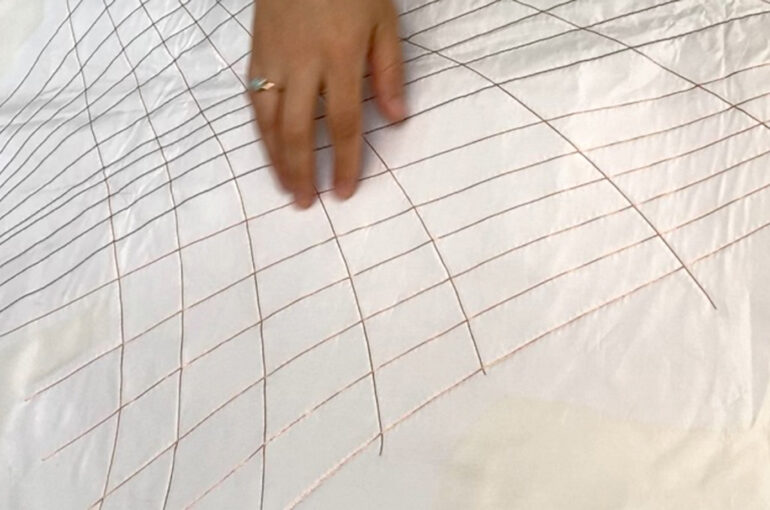Mid-Term Updates Embroidered Touch / Life Space

The following is an update on my work and research with Re-FREAM partners, whose support of this project is part of a larger effort to explore the future of fashion. I will share some of the lessons learnt from this collaborative process over the past four months as well as long term goals.
The tactile nature of working with textiles is central to my current machine embroidery project, ‘Touch (and staying in Touch),’ in collaboration with the Fraunhofer IZM. ‘Touch’ is the basis and guiding principle for developing the technology and design choices we are making throughout this project. It is particularly relevant while living during a pandemic, where social distancing and a lack of touch has become normalized and necessary. But what does it mean to live without touch, particularly in a fast-moving world that has become increasingly connected through technology; one where in-person human-to-human interaction has been replaced by texting and Zoom calls? What is being lost in that process, in terms of human connections that enable us to grow and evolve?
These are a few of the questions I’m considering as we explore how touch can be both personal and authentic through wearable technologies, such as embroidered textiles that transmit signals via Bluetooth. It is part of a deeper exploration into how the fabrics that touch our skin (the body’s largest organ) can provide a new and meaningful form of communication. Part of our process involves developing and testing embroidered materials with sensory properties that combine TEXPCB technology with knitting and embroidery. That process began in January and February, with research and readings into scientific and theoretical examples related to touch and its relationship to materials and technology. It was important to understand early on the existing knowledge and research on the topic in order to move forward and define a path for the project. The next step was to create samples of knits and embroideries to test ideas and refine them.
This initial research and exploration lead to our current phase, which explores ways to record ‘Touch INPUT’ through embroidery techniques that employ Fraunhofer TexPCB technology. By doing so, we are exploring how craft and technology, such as circuitry and sensors, can be integrated into the textiles we wear. This effort is being carried out in collaboration with the Fraunhofer team, to produce samples of smart textiles and embroideries that combine technologies that facilitate the INPUT and OUTPUT of sensory data brought on by touch. After these initial samples are created, the next phase and goal of the project will be to test these samples, to create an intuitive interface that is able to accurately capture and record touch-induced signals. Inevitably this phase involves learning through the process of making, as well as trial and error. It requires testing and questioning different approaches in terms of how we adapt and integrate the process of embroidery. This same approach will be used to explore ways to record ‘Touch OUTPUT’ as well.
Through this process, we are identifying how to employ certain technologies so they can effectively detect touch through a textile and reliably conduct those signals through the material. The next steps also include determining if there are any unwanted interference signals that may occur in smart textiles when worn on the body, to ensure the knit or embroidered material can reliably detect the INPUT and OUTPUT of information through touch. These initial results will provide further direction for refinements and tests to ensure the INPUT and OUTPUT of information are synchronized, so the experience feels intuitive and spontaneous, (as opposed to mechanical, such as pushing a button to achieve a predictable outcome).
Through this collaboration with Re-FREAM, the Fraunhofer IZM, Profactor and Empa, the goal of this project is to advance the knowledge and use of touch-sensitive embroidered textiles, that are integrated with conductive yarns capable of sensing changes in our moods and bodies. It is a concept born out of the pandemic we currently find ourselves living in, one informed by social unrest around the world, and the need for the fashion industry to employ more sustainable methods of producing and consuming garments. It is part of my ongoing research into smart textiles and wearable tech, one exploring how technology can be used in an ethical way to further positive outcomes during times of isolation and disruption.
Photo Ⓒ: Anke Loh





